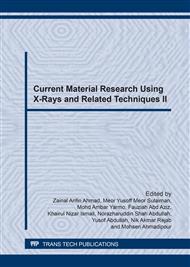[1]
N.A.M.Z. Abidin, N. Azraaie, N.A. Ibrahim, N.A.M. Razali, F.A. Aziz, S. Radiman, Study of XRD and FESEM characterization of cellulose from hardwood waste of resak (Vatica spp. ), Advanced Materials Research, 1087 (2015) 40-44.
DOI: 10.4028/www.scientific.net/amr.1087.40
Google Scholar
[2]
M.M. Haafiz, S.J. Eichhorn, A. Hassan, M. Jawaid, Isolation and characterization of microcrystalline cellulose from oil palm biomass residue, Carbohyd. Polym. 93(2) (2013) 628-634.
DOI: 10.1016/j.carbpol.2013.01.035
Google Scholar
[3]
A. Chakraborty, M. Sain, M. Kortschot, Reinforcing potential of wood pulp-derived microfibres in a PVA matrix, Holzforschung, 60(1) (2006) 53-58.
DOI: 10.1515/hf.2006.010
Google Scholar
[4]
M. Iguchi, S. Yamanaka and A. Budhiono, Bacterial cellulose—a masterpiece of nature's arts. J. Mater. Sci. 35(2) (2000) 261-270.
Google Scholar
[5]
R.E. Cannon, S.M. Anderson, Biogenesis of bacterial cellulose. Crc. Cr. Rev. Microbiol. 17(6) (1991) 435-447.
Google Scholar
[6]
C.C. Sweden, Natural resources and residues for production of bionanomaterials, handbook of green materials: processing technologies, properties and applications 4(5) (2014), 19.
Google Scholar
[7]
Y. Nishi, M. Uryu, S. Yamanaka, K. Watanabe, N. Kitamura, M. Iguchi, S. Mitsuhashi, The structure and mechanical properties of sheets prepared from bacterial cellulose. J. Mater. Sci. 25(6) (1990) 2997-3001.
DOI: 10.1007/bf00584917
Google Scholar
[8]
J. Shah, R.M. Brown Jr, Towards electronic paper displays made from microbial cellulose, Appl. Microbiol. Biot. 66(4) (2005) 352-355.
DOI: 10.1007/s00253-004-1756-6
Google Scholar
[9]
N. Halib, M.C.I.M. Amin, I. Ahmad, Z.M. Hashim, N. Jamal, Swelling of bacterial cellulose-acrylic acid hydrogels: sensitivity towards external stimuli. Sains Malaysiana, 38(5) (2009) 785-791.
Google Scholar
[10]
N. Halib, M.C.I.M. Amin, I. Ahmad, Unique stimuli responsive characteristics of electron beam synthesized bacterial cellulose/acrylic acid composite, J. Appl. Polym. Sci. 116(5) (2010) 2920-2929.
DOI: 10.1002/app.31857
Google Scholar
[11]
W. Czaja, A. Krystynowicz, S. Bielecki, R.M. Brown, Microbial cellulose—the natural power to heal wounds, Biomaterials, 27(2) (2006) 145-151.
DOI: 10.1016/j.biomaterials.2005.07.035
Google Scholar
[12]
J.D. Fontana, A.M. De Souza, C.K. Fontana, I.L. Torriani, J.C. Moreschi, B.J. Gallotti, S.J. De Souza, G.P. Narcisco, J.A. Bichara, L.F.X. Farah. Acetobacter cellulose pellicle as a temporary skin substitute, Appl. Biochem. Biotech. 24(1) (1990).
DOI: 10.1007/bf02920250
Google Scholar
[13]
N. Halib, M.C.I. M. Amin, I. Ahmad, Physicochemical properties and characterization of nata de coco from local food industries as a source of cellulose, Sains Malaysiana, 41(2) (2012) 205-211.
Google Scholar
[14]
L. Wang, G. Han, Y. Zhang, Comparative study of composition, structure and properties of Apocynum venetum fibers under different pretreatments, Carbohyd. Polym. 69(2) (2007) 391-397.
DOI: 10.1016/j.carbpol.2006.12.028
Google Scholar
[15]
W. Zhang, X. Zhang, M. Liang, C. Lu, Mechanochemical preparation of surface-acetylated cellulose powder to enhance mechanical properties of cellulose-filler-reinforced NR vulcanizates, Compos. Sci. Technol. 68(12) (2008) 2479-2484.
DOI: 10.1016/j.compscitech.2008.05.005
Google Scholar


